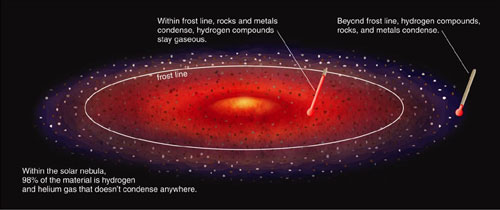| Jul 21, 2014 |
Transiting exoplanet with longest known year
|
|
(Nanowerk News) Astronomers have discovered a transiting exoplanet with the longest known year. Kepler-421b circles its star once every 704 days. In comparison, Mars orbits our Sun once every 780 days. Most of the 1,800-plus exoplanets discovered to date are much closer to their stars and have much shorter orbital periods.
|
|
"Finding Kepler-421b was a stroke of luck," says lead author David Kipping of the Harvard-Smithsonian Center for Astrophysics (CfA). "The farther a planet is from its star, the less likely it is to transit the star from Earth's point of view. It has to line up just right."
|
 |
| Depiction of the frost line. (Image: Pearson Education and Addison Wesley) (click on image to enlarge)
|
|
Kepler-421b orbits an orange, type K star that is cooler and dimmer than our Sun. It circles the star at a distance of about 110 million miles. As a result, this Uranus-sized planet is chilled to a temperature of -135° Fahrenheit.
|
|
As the name implies, Kepler-421b was discovered using data from NASA's Kepler spacecraft. Kepler was uniquely suited to make this discovery. The spacecraft stared at the same patch of sky for 4 years, watching for stars that dim as planets cross in front of them. No other existing or planned mission shows such long-term, dedicated focus. Despite its patience, Kepler only detected two transits of Kepler-421b due to that world's extremely long orbital period.
|
|
The planet's orbit places it beyond the "snow line" - the dividing line between rocky and gas planets. Outside of the snow line, water condenses into ice grains that stick together to build gas giant planets.
|
|
"The snow line is a crucial distance in planet formation theory. We think all gas giants must have formed beyond this distance," explains Kipping.
|
|
Since gas giant planets can be found extremely close to their stars, in orbits lasting days or even hours, theorists believe that many exoplanets migrate inward early in their history.
|
|
Kepler-421b shows that such migration isn't necessary. It could have formed right where we see it now.
|
|
"This is the first example of a potentially non-migrating gas giant in a transiting system that we've found," adds Kipping.
|
|
The host star, Kepler-421, is located about 1,000 light-years from Earth in the direction of the constellation Lyra.
|
|
This research has been accepted for publication in The Astrophysical Journal and is available online on arXiv ("Discovery of a Transiting Planet Near the Snow-Line").
|

